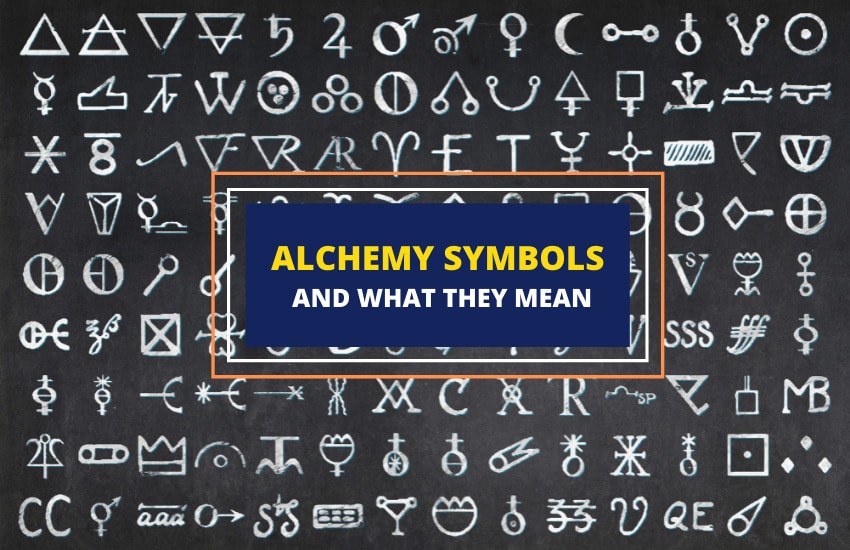
Table of Contents
Viewed as a science by its practitioners, as a mystic art by the uninitiated around them, and as impractical pseudo-science by scientists of the last 3 centuries, alchemy is a fascinating attempt at studying nature. Originating in the early centuries, alchemy first emerged in ancient Greece, Rome, and Egypt. Later on, the practice became popular all across Europe, the Middle East, India, and the Far East.
Alchemists used various symbols to represent natural elements. These symbols have existed for hundreds of years and continue to fascinate and intrigue people with their association to the mysterious art of alchemy.
What Exactly Is Alchemy?
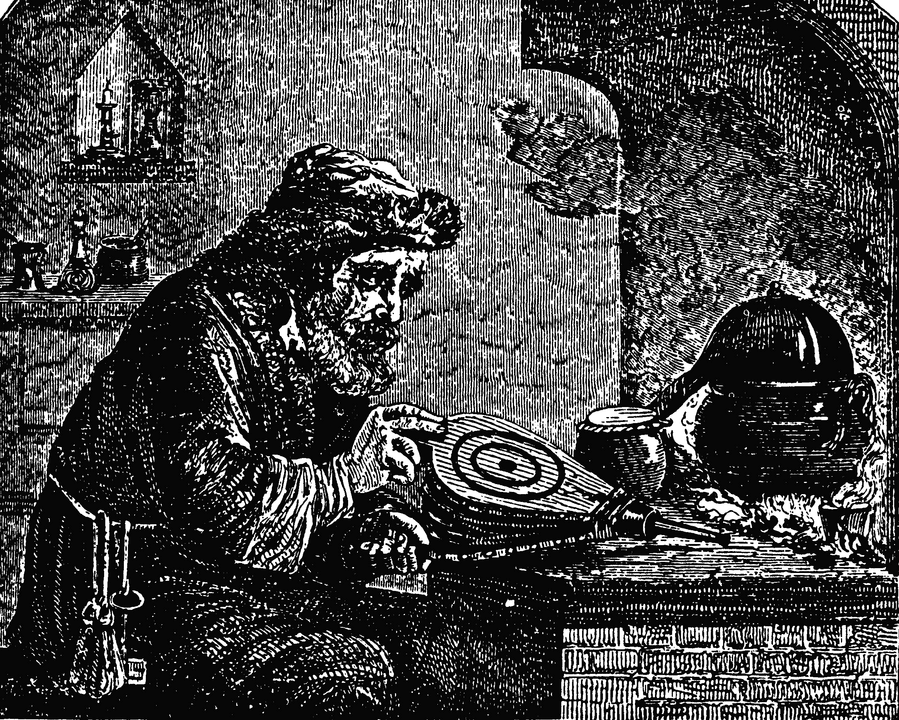
In essence, alchemy is the attempt of people in the ancient and Medieval times to understand chemistry and how chemical compounds interacted with each other. In particular, alchemists were fascinated by metals and believed there were ways for one metal to be transmuted into another one. This belief likely stemmed from people’s observation of mixed metal alloys in nature and how metals can change properties when they get smelted.
The main goals of most alchemists were the following:
- Find a way to transmute low-value metals into gold.
- Create the mythical Philosopher’s Stone by smelting and mixing different metals and elements. The Philosopher’s Stone was believed to be able to transform lead into gold as well as to grant eternal life to its user.
- Discover the elements of the elixir of eternal youth.
Whether all alchemists sincerely believed the latter two were possible isn’t clear – it’s possible they were just legends. However, all alchemists believed that metals can be transmuted into each other and so creating gold out of other metals for profit was on most alchemists’ minds.
All in all, alchemy can be described as an early attempt at chemistry but mixed with mysticism and astrology instead of actual science. Thus, as the collective understanding of physics and chemistry started advancing beyond alchemy in the 18th century, this ancient art began to die out.
However, this doesn’t mean that we should necessarily look down on alchemy. For its time, this mystic art represented most of what educated people knew about the world around them.
One famous alchemist, for example, was Sir Isaac Newton who lived in the late 17th and early 18th centuries. Newton’s belief that metals could be transformed into each other on a chemical level may have been wrong, but it didn’t make him any less of a scientist, evident from his revolutionary invention of Newtonian physics.
How Were Alchemy Symbols Used?
So, how do alchemy’s bizarre but beautiful symbols play into how alchemy works? Did alchemist actually write their symbols with chalk on the ground and try to summon magical powers like the heroes of Fullmetal Alchemist or The Rithmatist?
Of course not.
Alchemy symbols were merely the secret language alchemists used to describe their experiments and findings. The goal of these symbols was to describe the metals and processes alchemists used while keeping their secrets safe from any and all non-alchemists.
Famous Alchemy Symbols
Alchemy symbols can be simple or more complex, depending on what they represent. Many are based on astrology and are connected to or inspired by various celestial bodies.
Generally, most alchemy symbols are divided into four categories:
- The Four Classical Elements – Earth, wind, water, and fire, the elements that alchemists believed made up everything on Earth.
- The Three Primes – Mercury, salt, and sulfur, the three elements believed by alchemists to be the cause of all disease and illnesses.
- The Seven Planetary Metals – Lead, tin, iron, gold, copper, mercury, silver, the seven pure metals alchemist associated with the seven days of the week, certain parts of the human body, as well as the seven planetary objects in the Solar system they could observe with a naked eye.
- The Mundane Elements – All other elements explored by alchemy such as antimony, arsenic, bismuth, and others. As new elements were discovered, they were added to this growing list.
Here’s a look at some of the most popular symbols used in alchemy, how they were depicted and what they represented.
The Four Classical Elements
The four classical elements held great importance in the ancient world. Long before the alchemists, the ancient Greeks believed that the world and everything in it was made up of these four elements. In the Middle Ages, these classical elements began to be associated with alchemy and believed to have great powers. Alchemists also believed that the four elements could create new elements.
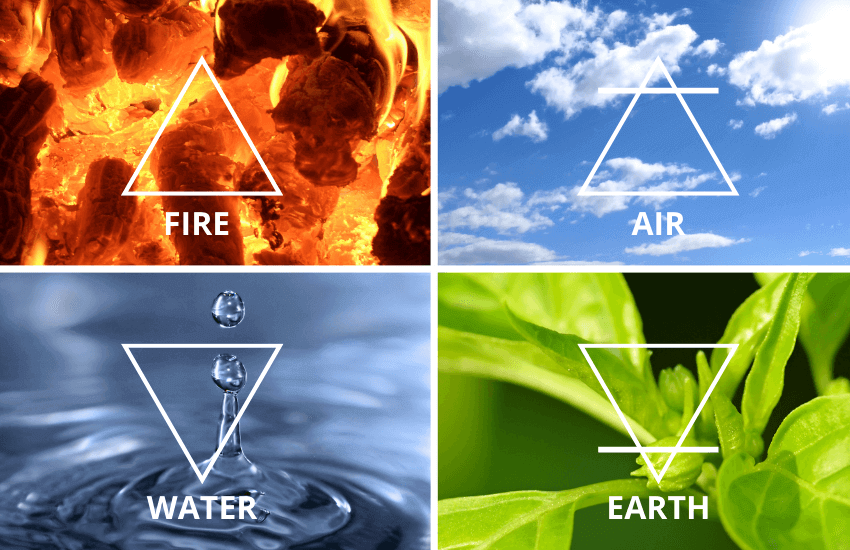
1. Earth
Depicted as an upside-down triangle struck with a horizontal line, the earth was associated with the colors green and brown. It represented physical movements and sensations.
2. Air
Drawn as an upward triangle struck with a horizontal line, air is the opposite of earth. It’s associated with heat and wetness (i.e., water vapor which alchemists connected to air instead of to water) and is viewed as a life-giving force.
3. Water
Shown as a simple upside-down triangle, the symbol of water is viewed as cold and wet. Its color is blue, and it’s also associated with human intuition.
4. Fire
A simple upward triangle, the symbol of fire represents various emotions such as hate, love, passion, and anger. Labeled as hot and dry by Aristotle, fire and its symbol are represented by the colors red and orange. It is the opposite of water in its depiction.
The Three Primes
These three elements were believed to be the poisons that caused all diseases and illnesses. Known as the tria prima, alchemists believed that if these poisons were studied, they would be able to identify why disease occurred and discover the ways to cure them.
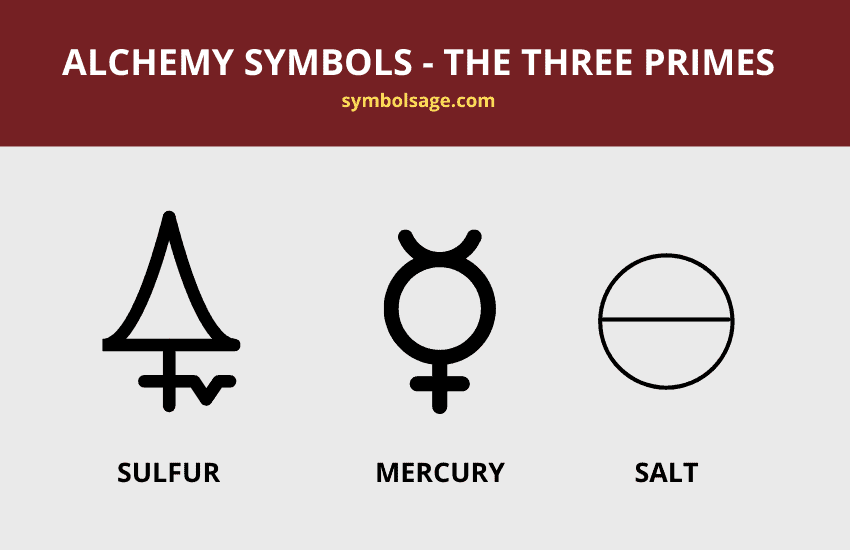
1. Mercury
Similar to the modern-day symbol of femininity but with an additional semi-circle on top of it, the symbol of mercury represents the mind. It’s also connected to a mental stated that was believed to be able to transcend death itself. Of the three primes, mercury is viewed as the feminine element.
2. Sulfur
Shown as a triangle with a cross underneath it, sulfur or brimstone was viewed as the active male counterpart of mercury’s feminine nature. This chemical is associated with properties such as dryness, heat, and masculinity.
3. Salt
Even though salt is actually made of sodium and chloride, alchemists viewed it as a single element. They represented salt as a circle with a horizontal line going through it. Salt is thought to represent the body, both male and female. Alchemists also associated salt with the process of purification of the human body because salt itself needs to be purified after it’s collected.
The Seven Planetary Metals
The seven planetary metals were metals known to the classical world. Each connected to one of the classical planets (Moon, Mercury, Venus, Sun, Mars, Jupiter and Saturn), a day of the week, and an organ in the human body. Because astronomy was closely connected to alchemy, especially in its early stages, it was believed that each planet ruled over its corresponding metal. This went as follows:
- The moon rules silver
- The sun rules gold
- Mercury rules quicksilver/mercury
- Venus rules copper
- Mars rules iron
- Jupiter rules tin
- Saturn rules lead
As Uranus and Neptune had not yet been discovered, they aren’t to be found on this list of classical planets. Here are seven planetary metals in more detail.
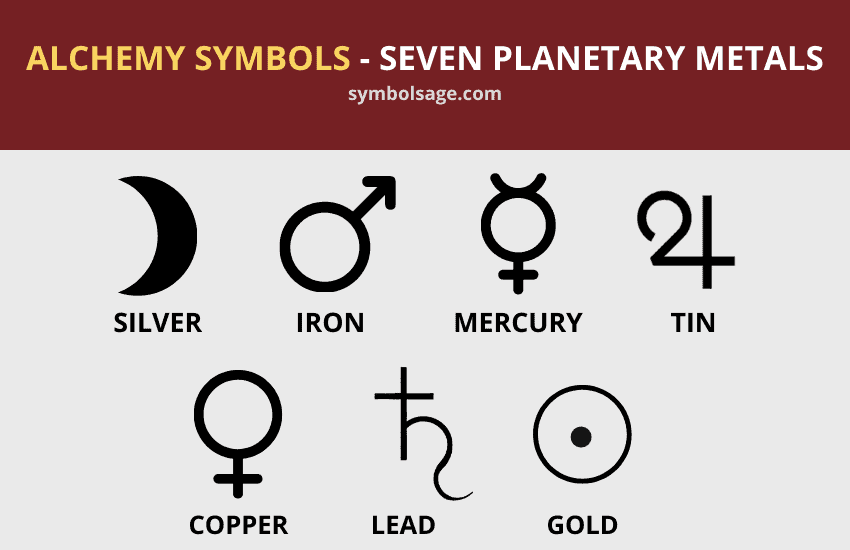
1. Silver
The symbol for silver looks like a crescent moon facing either left or right. This association is likely due to the moon’s often silvery color. In addition to representing that celestial body, silver also stood for the first day of the week Monday. It was also used as a symbol for the human brain.
2. Iron
Illustrated as the contemporary symbol for the male gender, i.e. a circle with an arrow sticking out of its upper-right side, iron is the symbol of the planet Mars. It also symbolizes the day Tuesday and the gallbladder in the human body.
3. Mercury
Yes, mercury gets a second mention because it’s a planetary metal as well as one of the three primes. Depicted by the same symbol, mercury represents the planet Mercury, the day Wednesday, as well as the human lungs.
4. Tin
The symbol for tin and the day Thursday can be best described as “a crescent above a cross”. It does look like the number 4 too, and it represents the planet Jupiter as well as the human liver.
5. Copper
As a symbol of the planet Venus, copper is depicted as the contemporary symbol for the female gender – a circle with a cross underneath it. There’s another common symbol for copper too which is a series of three horizontal lines crossed with two diagonal lines. Either way, both those symbols also represent the day Friday as well as the human kidneys.
6. Lead
Depicted almost as a mirror image to tin, the symbol of lead can be described as “a crescent below the cross”. It looks like a stylized lower-case h. Known as plumbum in the ancient times, lead was used to symbolize Saturday as well as the planet Saturn and the human spleen.
7. Gold
The last of the planetary metals is gold. Depicted either as a sun or as a circle with a dot in it, gold was viewed as the symbol of perfection. It also represented the day Sunday and the human heart.
The Mundane Elements
This category covers all the other elements known in alchemy. Many of these were added more recently to the list of alchemy symbols after they were discovered. The mundane elements don’t have the same rich history or profound representation as the other categories of alchemy symbols, but they still played various roles in alchemy and were used for various reasons.

1. Arsenic
The first mundane element on our list, Arsenic is depicted as an incomplete upward triangle placed over a full upside-down triangle. This image is also believed to look like two swans.
2. Antimony
Drawn as a reversed copper symbol, antimony represents the wild and untamed side of human nature. It’s also used as a symbol of the wolf.
3. Magnesium
Alchemists used magnesium carbonite or magnesium alba in their experiments as they didn’t have access to pure magnesium. It was believed to represent eternity because magnesium can’t be extinguished once it’s ignited. Multiple symbols have been used for magnesium with the most popular one looking like a sideways crown with a small cross on top.
4. Bismuth
Depicted as a semi-circle touching a full circle, the symbol for bismuth is one of the lesser-known alchemy symbols today as it was often mixed up with the symbols for lead and tin.
5. Platinum
Represented as a combination of the gold and silver symbols – a crescent moon touching a circle with a dot in it – platinum looks that way because alchemists thought the metal was an actual alloy of gold and silver.
6. Phosphorus
One of the more important elements for alchemists, phosphorus is drawn as a triangle with a double cross underneath it. Alchemists valued phosphorus above most other elements because of its ability to capture light and glow green when it oxidizes.
7. Zinc
Depicted quite simply with the letter Z and a small bar on its lower end, zinc can also be represented by several other symbols. Alchemists used to burn zinc into zinc oxide which they called “philosopher’s wool” or “white snow”.
8. Potassium
Alchemists used potassium carbonate in their experiments, as pure potassium isn’t found as a free element in nature. They represented it as a rectangle with a cross underneath and often called it “potash” in their experiments.
9. Lithium
The symbol of lithium in alchemy is drawn as a trapeze with a downward arrow going through and below it. While not much is known for how alchemists viewed or used lithium, this symbol is widely used in alchemy-related art today.
10. Marcasite
Alchemists loved this mineral as it tends to change properties depending on its surroundings. For example, when exposed to moist air it turns into green vitriol. Marcasite is drawn as a falling comet.
11. Aqua vitae
Known as the Spirit of Wine or ethanol, aqua vitae is formed by distilling wine. Its symbol in alchemy is a big V with a small s inside of it.
In Summary
There are hundreds of symbols related to alchemy. We’ve only listed the most popular alchemy symbols which were used heavily. In addition to the many other symbols for lesser-known elements and alloys, alchemists also used specific symbols to describe their equipment and their units of measurement. If you’re interested in a more comprehensive, and in-depth look into symbols of alchemy, we recommend checking out this book.
Alchemy symbols continue to be popular, often used in alchemy related artworks and depictions. As each alchemy symbol is associated with a particular element or compound, these symbols are used to depict the natural world and to represent the mystical perspectives of alchemy.








